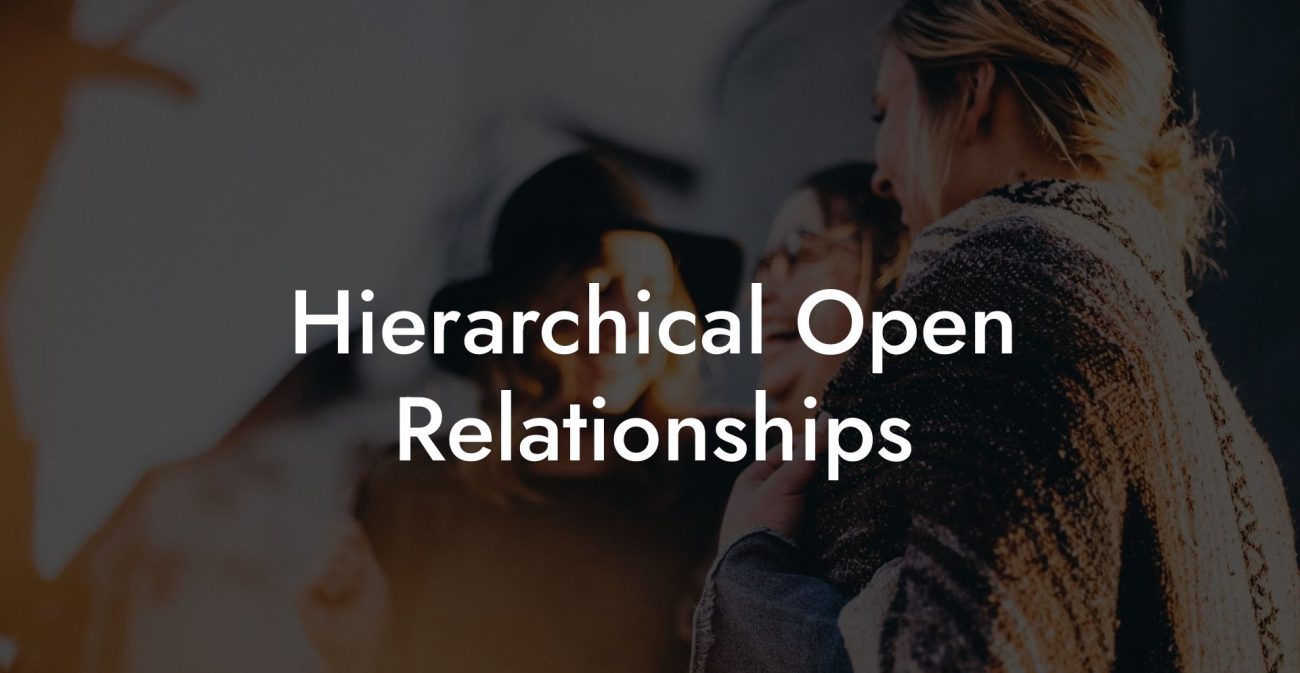Understanding Primary Relationship

A primary relationship often serves as the emotional anchor, providing stability and security amid a network of other connections. This guide will explore what a primary relationship is, why it is important in both monogamous and non-monogamous contexts, and offer practical strategies for cultivating and maintaining a strong primary bond. Whether you are in a traditional monogamous relationship or navigating a polyamorous network, this resource will provide insights and actionable advice to help you understand and strengthen your primary relationship.
Quick Links to Useful Sections
- What Is a Primary Relationship?
- Definition and Overview
- Core Characteristics of a Primary Relationship
- The Role of a Primary Relationship in Different Relationship Models
- In Monogamous Relationships
- In Consensual Non-Monogamy
- Why is the Primary Relationship Important?
- Emotional Security and Stability
- Shared Life Goals and Decision-Making
- Focus and Prioritization
- Challenges in Maintaining a Primary Relationship
- Balancing Time and Emotional Energy
- Managing Jealousy and Insecurity
- Communication Overload
- Strategies for Strengthening Your Primary Relationship
- Establish Open and Honest Communication
- Set Clear Boundaries and Priorities
- Invest in Self-Care and Personal Growth
- Foster a Supportive Environment
- Frequently Asked Questions (FAQ)
What Is a Primary Relationship?
Definition and Overview
A primary relationship is the central, committed bond in an individual’s romantic life. It is often characterized by a higher level of emotional intimacy, trust, and long-term commitment compared to other relationships. In monogamous contexts, the primary relationship is typically the only relationship, while in consensual non-monogamy, it serves as the anchor among multiple romantic or sexual connections.
In polyamorous or open relationships, the primary relationship is the connection that is prioritized above others. This bond often involves shared responsibilities, such as living together, financial planning, or parenting, and acts as the foundation on which other, less central relationships are built.
Core Characteristics of a Primary Relationship
- High Commitment: Partners in a primary relationship typically make a long-term, exclusive emotional commitment to one another, even if they are open to external connections.
- Deep Emotional Intimacy: The primary bond is characterized by a profound emotional connection and mutual understanding.
- Shared Life Goals: Primary partners often collaborate on significant aspects of life, such as career planning, finances, and family decisions.
- Trust and Security: A primary relationship provides a safe and stable environment where partners feel valued and secure.
The Role of a Primary Relationship in Different Relationship Models
In Monogamous Relationships
In a traditional monogamous relationship, the primary relationship is the only relationship. This exclusivity simplifies the dynamic, allowing partners to focus all their emotional, physical, and practical energy on each other. The strength of the primary bond in monogamy often leads to deep intimacy, trust, and security, supported by cultural, legal, and social frameworks.
In Consensual Non-Monogamy
In the context of polyamory or open relationships, the primary relationship remains the central, prioritized connection among multiple relationships. Here, it serves as an anchor that provides stability, even as partners form additional bonds. Designating a primary relationship helps manage the complexity of non-monogamous arrangements by clarifying priorities and establishing a baseline of trust and commitment.
While secondary or casual relationships can enrich an individual’s life with diverse experiences and support, the primary relationship is typically where the most significant emotional investment occurs.
Why is the Primary Relationship Important?
Emotional Security and Stability
The primary relationship is the cornerstone of emotional security. It offers a reliable base from which partners can explore other connections while knowing that their central bond is strong and secure. This security fosters trust and allows for vulnerability, which in turn deepens the intimacy between partners.
Shared Life Goals and Decision-Making
In many cases, primary relationships involve shared responsibilities such as cohabitation, financial planning, and parenting. By working together on these significant life decisions, partners can build a more integrated and resilient life together.
Focus and Prioritization
Especially in non-monogamous arrangements, designating a primary relationship helps ensure that the core bond receives the majority of time, energy, and attention. This prioritization is essential to prevent feelings of neglect and to maintain the overall health of the relationship network.
Challenges in Maintaining a Primary Relationship
Balancing Time and Emotional Energy
One of the most common challenges, particularly in non-monogamous contexts, is balancing the time and emotional energy between the primary relationship and other connections. It can be difficult to ensure that every partner feels valued without stretching oneself too thin.
Managing Jealousy and Insecurity
Even in well-structured primary relationships, feelings of jealousy and insecurity can emerge, especially when additional relationships are present. Addressing these emotions constructively requires open communication and the use of conflict-resolution strategies.
Communication Overload
With multiple relationships to manage, effective communication becomes even more critical. Regular check-ins, active listening, and clear dialogue are necessary to keep everyone on the same page, which can sometimes feel overwhelming.
Strategies for Strengthening Your Primary Relationship
Establish Open and Honest Communication
Communication is the lifeblood of any relationship. In a primary relationship, especially within a non-monogamous context, it is vital to:
- Schedule Regular Check-Ins: Dedicate time for one-on-one conversations to discuss feelings, challenges, and needs.
- Use "I" Statements: Express your emotions using statements like "I feel..." to minimize defensiveness and promote understanding.
- Be Transparent: Share updates and be honest about your experiences, ensuring that your partner is aware of any changes in your emotional landscape.
Set Clear Boundaries and Priorities
Define what the primary relationship means to you and how much time and energy you wish to invest in it. Establishing clear boundaries helps prevent misunderstandings and ensures that your primary partner feels valued. Consider:
- Defining Time Allocations: Agree on how much time you will dedicate to the primary relationship versus other interactions.
- Negotiating Expectations: Clarify what each partner needs from the relationship, whether emotional support, physical intimacy, or shared responsibilities.
- Documenting Agreements: Some couples find it helpful to write down their agreements and revisit them periodically to adjust as needed.
Invest in Self-Care and Personal Growth
Maintaining your well-being is crucial for the health of your primary relationship. Engage in activities that nurture your physical, emotional, and mental health:
- Practice regular self-care through exercise, meditation, or hobbies that bring you joy.
- Set personal goals that contribute to your growth and share these with your partner to foster mutual support.
- Consider individual or couple’s counseling to enhance your emotional resilience and communication skills.
Foster a Supportive Environment
Building and maintaining a primary relationship is easier when you have a network of support. Engage with communities that understand your relationship model:
- Join online forums or local support groups that focus on ethical non-monogamy and relationship dynamics.
- Attend workshops and seminars on relationship psychology to learn new strategies and share experiences.
- Encourage friends and family to be supportive of your relationship choices, helping to create an environment of acceptance.
Frequently Asked Questions (FAQ)
1. What is a primary relationship?
A primary relationship is the central, committed partnership that serves as the emotional anchor in an individual’s romantic life. It is the bond that receives the majority of time, energy, and commitment, especially in non-monogamous contexts.
2. How does a primary relationship differ from other relationships?
In a primary relationship, partners share a deeper emotional connection and often have more integrated lives, including shared responsibilities like cohabitation or financial planning. Secondary or casual relationships may offer additional support or variety but are not prioritized to the same extent.
3. Why is a primary relationship important in non-monogamous arrangements?
In non-monogamous settings, a primary relationship provides stability and security, ensuring that there is a central bond that anchors the individual’s network of relationships. It helps prevent feelings of neglect and maintains a sense of continuity and trust.
4. What are some common challenges in maintaining a primary relationship?
Challenges include balancing time and energy between multiple relationships, managing jealousy or insecurity, and ensuring consistent, effective communication among all partners.
5. How can couples strengthen their primary relationship?
Strategies include scheduling regular check-ins, setting clear boundaries and priorities, engaging in self-care practices, and seeking support through counseling or community resources.
6. Where can I find additional resources on primary relationships?
Additional resources include books such as "The Ethical Slut" by Dossie Easton & Janet Hardy and "More Than Two" by Franklin Veaux & Eve Rickert, podcasts like "Multiamory" and "Polyamory Weekly," and online communities such as r/polyamory.
Resources and Community Support: Your Next Steps
- "The Ethical Slut" by Dossie Easton & Janet Hardy – A foundational text that explores various relationship models and offers practical advice for building strong, healthy primary relationships.
- "More Than Two" by Franklin Veaux & Eve Rickert – An in-depth guide providing insights and strategies for managing multiple relationships, with a focus on nurturing your central bond.
- Podcasts: Listen to "Multiamory" and "Polyamory Weekly" for engaging discussions and real-life experiences about primary relationships and non-monogamous dynamics.
- Online Communities: Join forums such as r/polyamory to share experiences, ask questions, and receive support.
- Workshops and Webinars: Attend events focused on relationship psychology and ethical non-monogamy to expand your knowledge and connect with like-minded individuals.
By exploring these resources and applying the practical strategies outlined in this guide, you can develop a clear, informed understanding of what a primary relationship entails and learn how to nurture and sustain it, whether in a monogamous or non-monogamous context. Embrace open dialogue, continuous learning, and self-reflection as you build a relationship that is both secure and fulfilling.
Lost & confused by all of the terms, types and seemingly made up 3 letter acronyms?? We've got you. Check out our Ethnical Non-Monogamy Dictionary >>
Useful Interruption: Not sure which relationship vibe fits you best? Take our Relationship Test, it’ll give you the real insight into your natural relationship style. Then, dive into our binge-worthy guides (from the tried-and-true to the “wait, that’s a thing?”) and find the perfect relationship type for your life:
- Monogamy
- Open Relationships
- Ethical Non-Monogamy
- Solo Polyamory
- Non-Hierarchical Polyamory
- Hierarchical Polyamory
- Relationship Anarchy
- Swinging
Now back to the main article but yeah take the test...












